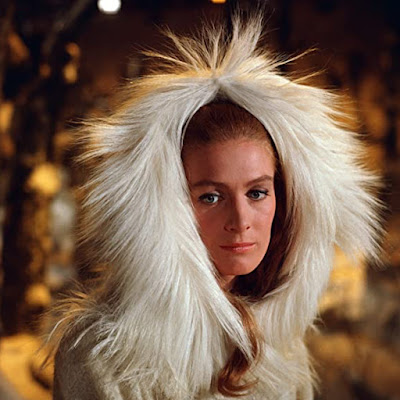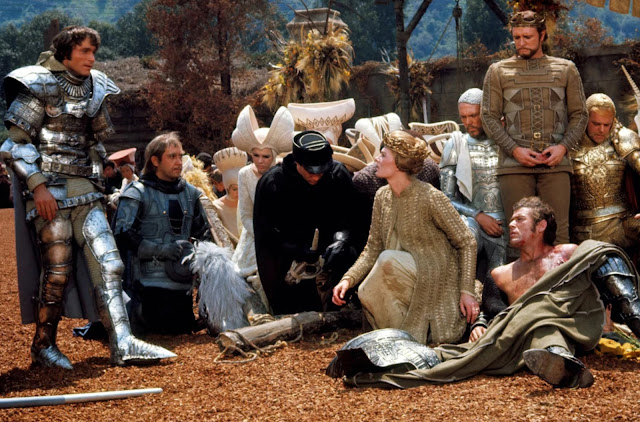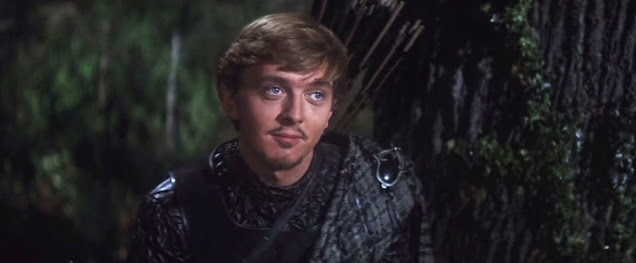 |
| Bob Peak’s poster art for Camelot |
I’ve been planning to watch Camelot ever since I started this review of Arthurian films, but I kept putting it off. It didn’t really appeal, to be honest. I think I was expecting it to be something like Merrie England epic Knights of the Round Table, but even longer, and with songs.
Well, it is long, and it does have songs, but nothing I’d heard about Camelot had quite prepared me for how visually splendiferous it is. Adapted from Lerner and Loewe’s Broadway musical, and directed by Josh Logan, it opens in the pre-dawn mist outside the walls of Joyous Garde, where Arthur’s army is besieging Lancelot and (we assume) Guinevere. Arthur (Richard Harris) is thinking back on the sequence of events which led to this sticky situation. The story begins properly with a flashback to his first meeting with Guinevere (Vanessa Redgrave) in the snowbound forest outside Camelot. The snowbound forest is a studio set, and an absolutely gorgeous one: completely artificial, but absolutely magical. I can’t find any still images which begin to capture the size of it or the beautiful, wintry, ochre light which seeps between the trees to colour the snow. You get a better look at in this scene.
Camelot is based on TH White’s The Once And Future King. The screenplay owes more to White that I had expected, and the snowy forest looks very much in keeping with his vision. Once the action moves to Camelot it feels altogether less British: the castle is glorious, but it looks sort of Spanish, and that’s for the very good reason that it’s in Spain. Combined with the constant sunshine, clear blue skies, dusty red earth, and azure seas, it makes the film feel more Californian than Arthurian. It’s nothing like my idea of Camelot, but it still looks splendid. This Camelot teems with knights, ladies, men-at-arms, jugglers, stilt-walkers, merchants, horses, birds, and dogs. The interiors are crammed with detail too.
Richard Harris wears slightly more eye shadow than you’d expect King Arthur to bother with (he sometimes looks as if he’s recently walked into a door), but he’s tremendously engaging and sympathetic, if perhaps a little too boyish on occasion. Vanessa Redgrave, whom I know only in her later incarnation as a grande dame and posh-left firebrand, is a revelation: intelligent and funny, girlish and dignified, she’s surely the best Guinevere ever put on screen.
And the costumes! John Truscott designed those too, and he dresses Guinevere in a series of jaw-dropping outfits. The other ladies of the court wear some of the biggest hats I’ve ever seen: gathering together to watch the joust, they resemble a crop of giant mushrooms. (Weirdly, I kept being reminded of David Lynch’s Dune. I wonder if Camelot was an influence on it?)
TH White’s Lancelot in the book is ugly. This Lancelot certainly isn’t, but there is something weirdly unappealing about him all the same. He has the cold blue eyes of Ray Liotta and the restless bushy eyebrows of Frankie Howerd, and he’s all moi, moi, moi. I wondered why on earth Guinevere would fall for him. But, it turns out, she doesn’t - she thinks he’s a ghastly French prig too, and is soon persuading Arthur’s tougher knights to teach him a lesson at the next tournament. Only when Lancelot defeats them does she finally admit to herself that he’s hot stuff, not because of his physical prowess but because of his despair when he believes he’s killed Sir Sagremor.
Arthur knights Lancelot, but the attraction between him and Guinevere is already obvious, and Richard Harris has a good soliloquy where he realises what a pickle they’re in - Guinevere is the woman he loves, Lancelot has become his dearest friend, and yet they’re betraying him, or at least he knows they will. ‘I want… vengeance!’ he says, but he sort of swallows the word ‘vengeance’ because even as he says it he knows it isn’t what he wants at all.
Of all the Arthur films I’ve watched, this is the only one which really tries to get to grips with the personal tragedy of the central love triangle. It reminded me faintly of David Lean’s Doctor Zhivago in that the marriage feels far more convincing and satisfying than the passionate love affair that destroys it. Harris and Redgrave have much more chemistry together than Redgrave and Nero. That isn’t a criticism of the film, though, because it just adds another layer of irony to the many that are already operating - Lancelot is drawn to Camelot by its ideals, and ends up destroying it: Arthur creates a system of justice that binds him as well as his subjects, and is then entrapped by it when his own wife breaks his laws.
Anyway, there is an odd sort of break which is probably where the intermission would have gone if you’d watched Camelot at the local Odeon in 1967, and by the time we’ve finished our cartons of Kia-Ora and tubs of Lyons Maid Lancelot and Guinevere have been lovers for some time. The Round Table is getting a bit depleted, because knights keep accusing Lancelot of canoodling with the queen, he challenges them to prove it by single combat, they lose, and are banished from court. It’s a problem for Arthur, but an opportunity for Mordred, who enters the story at this point, played by David Hemmings and clad in a stylish suit of oxblood leather with matching hat and boots. He’s Arthur’s bastard son, the result of a long-ago fling with Princess Morgause of Orkney. Arthur cautiously welcomes him to Camelot, hoping that ‘there is some part of me in him that I can awaken’. There isn’t.
Hemmings is perfectly cast. One of the New Wave boys, fresh from his turn in Antonioni’s Blow Up, he swaggers into Camelot with the arrogant cool of a Rolling Stone gatecrashing a society wedding. Pretty soon he has the upper hand, and the knights who follow him are brawling in the corridors and riding their horses onto the Round Table itself.
The colour schemes darken Excalibur-ishly. Arthur, despairing, seeks the solitude of the forest, where he dreams of Merlin. While he’s away, Mordred and his knights trap Guinevere and Lancelot, Lancelot escapes, and Guinevere stands trial in Arthur’s new court of justice, which looks like a Rembrandt painting, with the faces of the jury and officials looming out of a deepening gloom. Guinevere is sentenced to be burned at the stake, Lancelot rides in to rescue her, and so we arrive back at the scene where the the film began, with Arthur’s army encamped outside Joyous Garde.
It’s all surprisingly effective, and affecting. I can see why it was a hit, and won Oscars (for best Art Direction, Costume Design, and Music: Richard Harris picked up a Golden Globe). My only doubt was the songs themselves. I’m not musical, and usually have to listen to a song a few times before I can decide if I like it or not, or even identify the melody, so I’m prepared to accept they’re growers. (The only songs from Camelot I’d heard before are the title number and Follow Me, which Blondie covered, but Follow Me is reduced to background music - it’s sung by Morgan le Fay in the stage show, but she’s been cut from the film, presumably in an effort to keep it under the four-hour mark.) So I’m probably not the best person to judge Camelot’s score on a single viewing, but I think it may be fair to say it’s not up to the standards of other big ‘60s movie musicals like Oklahoma, My Fair Lady, or The Sound of Music, in which every number is a showstopper. There are fewer big chorus numbers than I expected, and apart from the Lusty Month of May sequence there’s not a lot of the lavish choreography I associate with this sort of film. Instead there are lots of duets and solos, mostly fairly slow and thoughtful, and particularly in the second half I felt they got in the way of the story rather than adding to it. Harris and Redgrave are so good, and the story underneath all the sumptuous film-flam is so strong, that it doesn’t really seem to need songs as well.
In the final scene, as Arthur’s army prepares to attack, and he contemplates the ruins of all his dreams, he meets a young boy who has joined the army because he was inspired by tales of the Round Table. Arthur, realising that all is not lost if the memory of Camelot survives, tells the boy to run home and remember, and he knights him: Sir Tom of Warwick. He is presumably Sir Thomas Malory, whose Morte D’Arthur drew together so many of the different strands that make up the Arthurian Legends, and who has inspired, directly or indirectly, most of the Arthurian films I’ve been writing about on this blog.
It’s an appropriate tribute. I can’t actually remember if TH White ends The Once And Future King with a guest appearance by Malory, but that’s certainly how he begins it: this is the dedication in the front of The Sword in the Stone:
















Comments